Progressive tax scales: what are there in the world
[ad_1]

At the beginning of October, a bill introducing a new progressive scale of taxation on personal income in Russia was introduced into the State Duma. Its authors propose to abolish income tax for citizens who earn 360 thousand rubles a year. or less (about 30 thousand rubles per month) and raise tax rates for those who earn over 10 million rubles. per year (approximately 833 thousand rubles per month). How taxes are paid in different countries – in the Kommersant material.
Flat and progressive tax
A flat tax system is a system in which all citizens pay income tax at the same rate (for example, 13%). With a progressive scale, tax rates differ depending on the payer’s earnings. The higher the income, the higher the government’s percentage. According to EY experts, developing countries mainly use a flat scale and relatively low rates. Developed economies most often introduce a progressive tax, the upper limit of which can reach 50% or higher.
For example, in the United States, federal tax for 2022/2023 and 2023/2024 is paid at seven rates: 10%, 12%, 22%, 24%, 35% and 37%. The final tax depends on marital status and income.
The rule is this: every new dollar earned is worth more than the previous one. If a single American earned $50 thousand, he will pay taxes at a rate of 10% on the first part of earnings of $10,275 (that is, $1027.5), at a rate of 12% on the second part from $10,276 to $41,755 ($3,780) and at the rate 22% – from the balance from $41,755 to $50 thousand ($1813.9). In total, such an American’s tax will be $6621.4 (approximately 13%).
In China, personal tax is levied on a progressive scale with rates of 3%, 10%, 20%, 25%, 30%, 35%, 45%. The final amount is calculated using deductions. If deductions are equal to or greater than earnings, no tax is actually paid.
If a Chinese person earns 50 thousand yuan per month, he will first apply the universal deduction of 5 thousand yuan, then calculate the interest on the balance amount and make a deduction at the chosen rate. The formula looks like this: ((50,000 − 5000) * 10%) − 2520 = 1980 yuan. As a result, the tax for a Chinese resident will be approximately 4%.
The calculation methods and number of tax rates differ from country to country. In Russia they propose to introduce six levels: from 0 to 360 thousand rubles. (0%), from 360 thousand to 5 million rubles. (13%), from 5 million to 10 million rubles. (15%), from 10 million to 50 million rubles. (25%), from 50 million to 100 million rubles. (30%), from 100 million rubles. (35%). By comparison, Luxembourg has approximately 20 steps and tax rates ranging from 0% to 42%.
Some countries introduce a tax-free minimum. If a taxpayer earns less than the accepted amount, he is effectively exempt from tax. In the UK, this minimum is about £12.5 thousand (€14.4 thousand), in Austria – €11 thousand, in France – approximately €10.8 thousand.
How do they pay in Russia?
In the Russian Empire, income tax appeared on February 11, 1812. It was paid by landowners from income from real estate. The tax-free minimum was 500 rubles. per year, otherwise the rate ranged from 1% to 10%. In the USSR, income tax was introduced by decree of November 16, 1922. The authorities have repeatedly revised the rates, but the tax itself most often remained progressive (for example, from 0% to 11%).
In the 1990s in Russia, income taxes ranged from 12% to 30% (initially from 12% to 40%). The minimum rate applied to citizens whose income was 50 thousand rubles. or less, the average of 20% – for amounts from 50 thousand to 150 thousand rubles, the highest of 30% – for incomes above 150 thousand rubles. In January 2001, the authorities abandoned the progressive scale and introduced a flat tax of 13%. Following the changes, income tax revenues for the first quarter of 2001 increased by 70% compared to the same period the previous year, in real terms by 30–40%.
In June 2020, President Vladimir Putin proposed abandoning the flat scale of personal income tax and increasing the rate from 13% to 15% for citizens whose income exceeds 5 million rubles. in year. The progressive scale began to be applied again from January 2021.
Fighting inequality
According to one of the authors of the bill, deputy from the LDPR faction Yaroslav Nilov, changes to the tax scale are necessary “against the backdrop of ongoing property stratification in society and are aimed at strengthening social support measures for citizens.”
At the same time, EY experts believe that a progressive tax scale in itself is not a method of combating inequality among the population. South Africa uses a progressive tax from 18% to 45%. At the same time, the country often tops the rankings in terms of the stratification of society indicator (GINI).
[ad_2]
Source link





